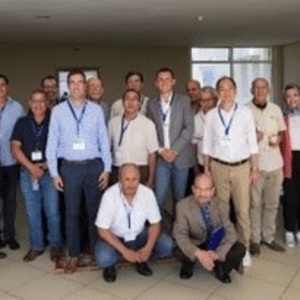USGC works to expand DDGS use for aquaculture in Morocco

SOURCE: U.S. Grains Council
September 21, 2022
BY U.S. Grains Council
Staff from the U.S. Grains Council’s Europe, Middle East and Africa (EMEA) office traveled to Morocco in laste August to enhance its aquaculture engagement in the region, as it sees the industry as a significant growth opportunity for U.S. distillers dried grains with solubles (DDGS).
The majority of the 3.5 million metric tons (MMT) of U.S. feed grains exported to Morocco are used by the poultry and ruminant sectors. However, the growing demand for high-protein foods in Morocco, a trend similarly seen across North Africa more broadly, is creating new opportunities for the domestic aquaculture industry, which simultaneously is creating a new prospect for U.S. feed grain uses within Morocco.
To help in this effort, the Council invited Ronnie Tan, USGC regional aquaculture specialist based in Southeast Asia, to assist with the promotion of the aquaculture program in Morocco.
Advertisement
The office organized a large national aquaculture event on Aug. 31. The event covered many of the hot topics in the industry, such as aquaculture feed demand; outlook, trends and opportunities for DDGS; the integrated model for shrimp and tilapia; current threats to the industry; and solutions DDGS can provide.
“The event gathered a sizable number of participants, most of them from the feed industry, the public and private sector and several future investors in the aquaculture industry,” said Mohamed Salah Bouthour, USGC assistant regional director for Africa. “The audience was thirsty to hear from the USGC experts addressing proteins constraints – specifically regarding aquaculture – and providing insight on the global production outlook with more information on the use of U.S. corn co-products with a focus on nutrition and performance in tilapia and shrimp species.”
Morocco currently produces an estimated 1.4 MMT of seafood annually, making it the largest maritime fisheries producer in Africa and the 25th largest producer globally. While Morocco possesses a relatively strong fisheries industry, contributing to 2.3 percent of gross domestic product annually, overfishing limits the overall productivity and sustainability of the industry. Per capita consumption of fish in Morocco is estimated to range between 10 and 12 kilograms (22.04 and 26.45 pounds) annually, well under the global average of 20 kilograms (44.08 pounds) per person estimated by the Food and Agriculture Organization (FAO).
Advertisement
“The aquaculture market in Morocco is relatively small compared to other countries in the region, especially Egypt, which is the largest tilapia-producing country in the Middle East and Africa area,” Bouthour said. “Morocco’s aquaculture feed production represents only 1,000 metric tons of the total balanced feed produced. The Council will continue to support the growth of the aquaculture animal husbandry industry in the country by empowering Moroccan investors and local feed millers with relevant knowledge and technical skills through educational programming funded by our USDA Section 108 Aquaculture grant.”
Section 108 funds will help the Council initiate a three-year aquaculture project in Morocco to support the development and expansion of the aquaculture sector in the country and support the industry in addressing the bottlenecks and constraints prohibiting enhanced production. Through these efforts, the Council believes the aquaculture industry in Morocco will grow and create opportunities for U.S. DDGS exports to Morocco.
Related Stories
Bangkok Airways Public Company Limited has officially announced the adoption of sustainable aviation fuel (SAF) on its commercial flights, reinforcing Thailand’s green aviation industry. The initiative took effect starting July 1, 2025.
Avalon Energy Group LLC and Sulzer Chemtech have signed a strategic alliance and partnership agreement to scale up the production of SAF. Under the agreement, Avalon has selected BioFlux technology for its portfolio of SAF projects.
Neste and DHL Express have strengthened their collaboration with the supply of 7,400 tons (9.5 million liters) of neat, i.e. unblended, Neste MY Sustainable Aviation Fuel to DHL Express at Singapore Changi Airport starting July 2025.
CoBank’s latest quarterly research report, released July 10, highlights current uncertainty around the implementation of three biofuel policies, RFS RVOs, small refinery exemptions (SREs) and the 45Z clean fuels production tax credit.
The U.S. Energy Information Administration maintained its forecast for 2025 and 2026 biodiesel, renewable diesel and sustainable aviation fuel (SAF) production in its latest Short-Term Energy Outlook, released July 8.
Upcoming Events










